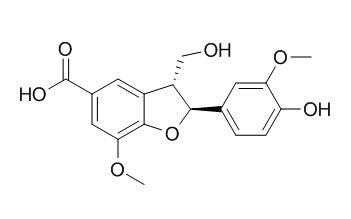Ceplignan
(2S,3R)-Ceplignan and (2R,3S)-Ceplignan significantly enhances SERT activity, can used in treatments of neuropsychiatric and digestive disorders.
Inquire / Order:
manager@chemfaces.com
Technical Inquiries:
service@chemfaces.com
Tel:
+86-27-84237783
Fax:
+86-27-84254680
Address:
1 Building, No. 83, CheCheng Rd., Wuhan Economic and Technological Development Zone, Wuhan, Hubei 430056, PRC
Providing storage is as stated on the product vial and the vial is kept tightly sealed, the product can be stored for up to
24 months(2-8C).
Wherever possible, you should prepare and use solutions on the same day. However, if you need to make up stock solutions in advance, we recommend that you store the solution as aliquots in tightly sealed vials at -20C. Generally, these will be useable for up to two weeks. Before use, and prior to opening the vial we recommend that you allow your product to equilibrate to room temperature for at least 1 hour.
Need more advice on solubility, usage and handling? Please email to: service@chemfaces.com
The packaging of the product may have turned upside down during transportation, resulting in the natural compounds adhering to the neck or cap of the vial. take the vial out of its packaging and gently shake to let the compounds fall to the bottom of the vial. for liquid products, centrifuge at 200-500 RPM to gather the liquid at the bottom of the vial. try to avoid loss or contamination during handling.
Anticancer Res.2022, 42(9):4403-4410.
Food Science.2023, 4(20):268-282.
Plant Cell Tiss Org2017, 479-486
Nutrients.2023, 15(4):950.
Foods.2024, 13(19):3092.
Phytother Res.2023, 37(10):4587-4606.
Molecules.2023, 28(8):3376.
Microchemical Journal2023. 191:108938
Environ Toxicol.2023, 38(5):1174-1184.
FASEB J.2022, 36(7):e22387.
Related and Featured Products
Bioorg Med Chem Lett. 2015 Aug 6. pii: S0960-894X(15)00825-2.
A novel sesquiterpene and three new phenolic compounds from the rhizomes of Acorus tatarinowii Schott.[Pubmed:
26296476]
METHODS AND RESULTS:
A novel sesquiterpene with an unprecedented epoxy lactone skeleton, named tatarinolactone, together with two new amides, a new biphenylpropanoid and two known lignans were isolated from the rhizomes of Acorus tatarinowii Schott. Their structures were identified as 6,7,8-trihydroxy-4α-isobutyl-4,7-dimethylhexahydro-6,8α-epoxychromen-2(3H)-one (1), (E)-methyl 4-[3-(4-hydroxy-3-methoxyphenyl)acrylamido]butanoate (2), (Z)-methyl 4-[3-(4-hydroxy-3-methoxyphenyl)acrylamido]butanoate enol isomer (3), (R)-4-hydroxy-3-[1-hydroxy-3-(4-hydroxy-3-methoxyphenyl)propan-2-yl]-5-methoxybenzoic acid (4), (2S,3R)-Ceplignan (5), and (2R,3S)-Ceplignan (6), respectively, based on extensive spectroscopic analysis and by comparison to the known compounds. To test their effects on serotonin transporters, a high content assay using hSERT-HEK293 cell line was adopted.
CONCLUSIONS:
Results indicated that compounds 1 and 4 significantly inhibited SERT activity, while compounds 2, 3, 5, and 6 significantly enhanced SERT activity, which partly explain the traditional uses of the rhizomes of Acorus tatarinowii Schott in treatments of neuropsychiatric and digestive disorders.



